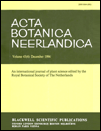GROWTH-PHYSIOLOGY, SALT-TOLERANCE AND MINERAL NUTRITION OF CENTAURIUM LITTORALE (TURNER) GILMOUR: ADAPTATIONS TO ITS OLYGOTHROPHIC AND BRACKISH HABITAT
SUMMARY
Centaurium littorale was cultured under various conditions of nutrient availability, salinity and pH. The mineral composition of the experimental plants and of plants from a field site was investigated. The highest relative growth rate observed was 0.02 mg.mg.−1 day−1 and the shoot: root ratio was 0.8. Optimal growth occurred at very low nutrient availability. Suction tensions below 7 atm had no strong effect on the growth rate. There was a marked accumulation of NaCl in the tissues without a negative effect on the uptake of nutrient ions. In the pH-range 7.7–4.8 growth was equal. In its growth physiology and mineral nutrition Centaurium littorale is well adapted to the habitat: the brackish and poor young dune soil.




